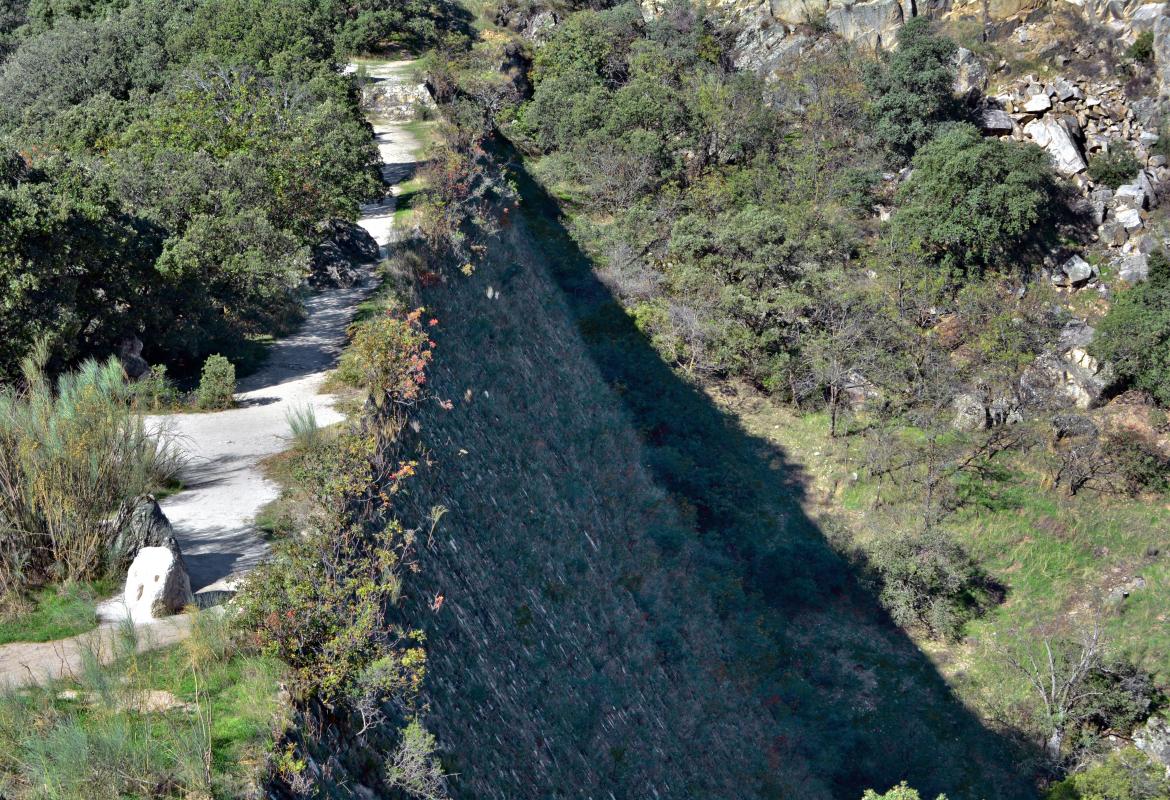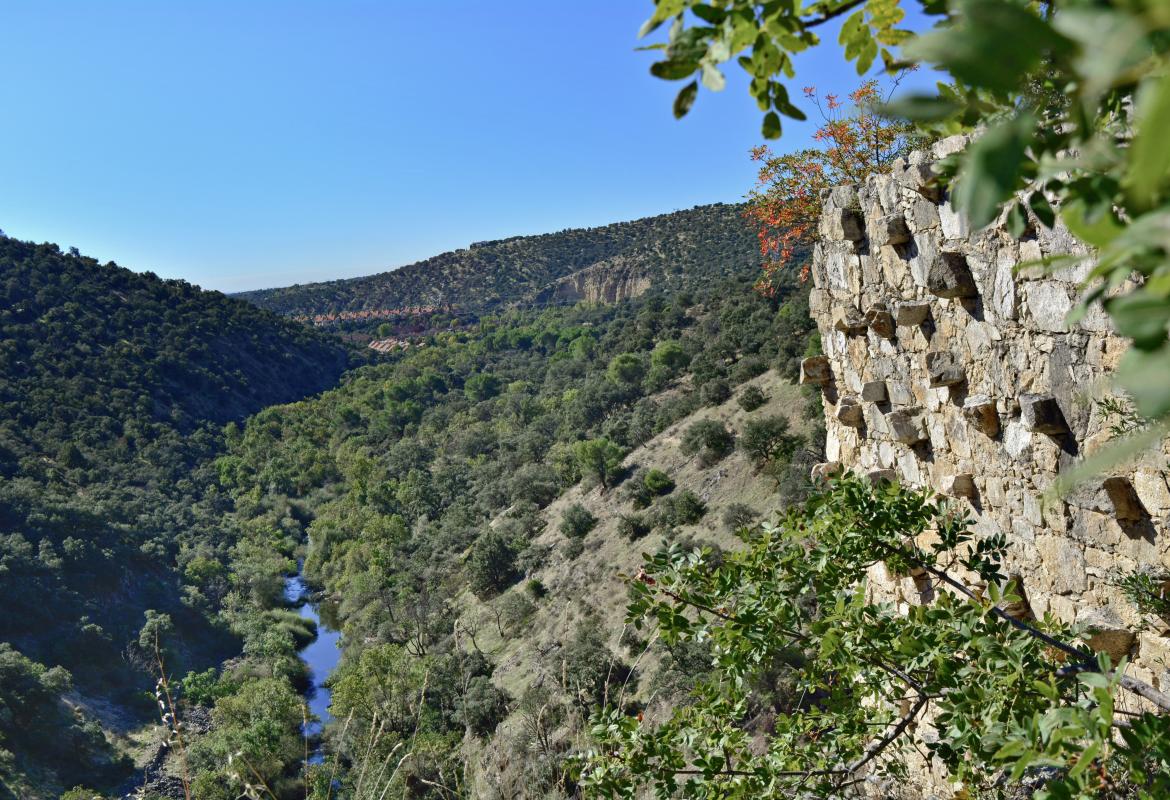

The El Gasco Dam and the Guadarrama Canal
Property of Cultural Interest in the category of Cultural Landscape.
The complex formed by the El Gasco Dam and the Guadarrama Canal, located in the municipalities of Galapagar, Torrelodones and Las Rozas, in a granite gorge on the course of the Guadarrama River, constitutes an outstanding unfinished hydraulic infrastructure, within a project large-scale historic engineering building, designed in 1785 by the French military engineer Carlos Lemaur.
Despite the unsuccessful goal of connecting the city of Madrid and the Atlantic Ocean by means of a navigable canal, the result of the El Gasco dam constitutes a remarkable example of anthropic action on nature, framed in the great projects of public engineering works that They were promoted in the reign of Carlos III. The El Gasco dam, if it had been completed, would have been a milestone in the construction of this type of work, designed as the largest in the world at that time. That is why it has been declared an Asset of Cultural Interest in the category of Cultural Landscape.
initial image
Historic context
Although since the XNUMXth and XNUMXth centuries, projects for the creation of a navigable canal that would serve Madrid and join the Jarama and Manzanares rivers had been proposed in Spanish territory; they never materialized. In the XNUMXth century, inland navigation hardly existed in Spain, a situation that the Bourbon dynasty tried to remedy after coming to the throne. Taking as reference the French infrastructures built in the XNUMXth century; the Bourbon monarchs encourage the construction of new hydraulic works projects such as the case of the El Gasco Dam.
The lack of experience and the absence of national technicians who could face projects of these characteristics, led to the incorporation of foreign engineers, grouping since 1711 around the Academy of the Army Corps of Engineers. In this context, the arrival in Spain of the renowned French military engineer Carlos Lemaur takes place, who will be contacted by the National Bank of San Carlos to prepare a feasibility study and layout of a navigable channel and a dam. For the Banco de San Carlos, the project could mean boosting its financial activity, while for Lemaur it meant reinforcing his work as an engineer in Spain, under royal protection.
In 1785 Lemaur and his four sons, also engineers, were employed in the work of documentation and reconnaissance of the land and precise leveling for the construction of the canal, planned with a total length of 771 km that would connect Madrid with the Atlantic Ocean, communicating the waters of the Guadarrama, Manzanares, Tagus and Guadalquivir rivers. A use of the Guadarrama Canal was proposed for the transport of materials, irrigation of adjoining land, installation of mills and other hydraulic devices, optimizing the canal as a resource to the maximum.
After the sudden death of Lemaur, the works began in 1786, directed by his sons, and lasted until 1799, the year in which an intense storm caused the partial destruction of the dam by collapsing part of the wall due to the accumulation of water in the cells. interiors. The magnitude of the repair costs, together with various situations related to the situation and availability of the Lemaur brothers, determined the definitive stoppage of the work and its subsequent abandonment.
Throughout the XNUMXth century and the beginning of the XNUMXth, some proposals were put forward to recover the infrastructure with other uses, such as the reuse of the canal for irrigation and, to a lesser extent, of the dam due to the high cost that its repair would entail.
patrimonial values
The Cultural Landscape of the El Gasco dam is formed by the dam itself, which owes its name to the homonymous mount, within the Regional Park of the Middle Course of the Guadarrama River and by the Guadarrama Canal, whose original project managed to open some twenty-five kilometers, from the vicinity of the dam to the urban center of Las Rozas. Auxiliary works such as aqueducts or sewers are added to the complex to save the passage of the canal over streams and ravines, auxiliary paths and the towpath proposed as a service route for the canal.
In the same way, the declaration includes the quarries for extracting stone for construction, the Caz del Arroyo de la Torre and a series of houses located on the banks of the river: Casas del canal, Casa del guardian, Casa de la presa , etc. All these elements make up a vestige of eighteenth-century engineering in symbiosis with the native landscape, the forest and the course of the river.
Its high cost and complex execution, management and maintenance, prevented the work from being resumed after the partial collapse of 1799. Despite this, it constitutes an important sample of the great hydraulic works begun in Spain in the XNUMXth century; next to the Canal de Castilla and the Canal Imperial de Aragón. The relevance of the Guadarrama Canal and the dam placed it as an outstanding project within the public works policies of Carlos III.
The dam has been preserved to this day, practically without any other alteration than the growth of vegetation in some points, despite the more than two centuries since the stoppage of the work and the urban boom experienced in the area, especially in the last third of the twentieth century. On the other hand, the natural value of the site deserves special mention, from the topographical, biological and geomorphological points of view. Its peculiar topography makes it possible to perceive the complex as a visual unit in which human work can be appreciated, taking advantage of the deep fit of the river in the granite massif.
Image gallery
protected heritage
The Patron Saint Festival of San Isidro, the Ecce Homo attributable to Caravaggio and the Piedra Escrito site are some of the assets declared by the Community of Madrid in 2021.













